| Srl | Item |
| 1 |
ID:
096544
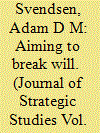

|
|
|
|
|
| Publication |
2010.
|
| Summary/Abstract |
Current US Air Force doctrine emphasizes attacking an enemy's 'will to resist' without defining 'will'. Much of the Air Force's focus on will stems from prewar bombing doctrine and America's initial effort to break an enemy's morale with bombs - the aerial assault on Nazi Germany. That bombing revealed that a nation-state's will to resist actually consists of three distinctive elements - the will of its populace, government leaders, and the armed forces - which together form a collective desire to fight. The bombing also showed that the resilience of the individual components depends on the strength of the bonds that connect them and the war aims pursued by all belligerents. It further illustrated that the individual element most likely to break from air attack is the will of the armed forces.
|
|
|
|
|
|
|
|
|
|
|
|
|
|
|
|
| 2 |
ID:
096545
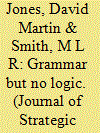

|
|
|
| 3 |
ID:
125200
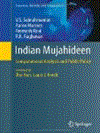

|
|
|
|
|
| Publication |
New Delhi, Springer, 2013.
|
| Description |
xviii, 173p.Hbk
|
| Series |
Terrorism, Security, and Computation
|
| Standard Number |
9783319028170
|
|
|
|
|
|
|
|
|
|
|
|
Copies: C:1/I:0,R:0,Q:0
Circulation
| Accession# | Call# | Current Location | Status | Policy | Location |
| 057503 | 364.1066/SUB 057503 | Main | On Shelf | General | |
|
|
|
|
| 4 |
ID:
183933


|
|
|
|
|
| Summary/Abstract |
This paper studies the Korean War from an environmental perspective. The paper examines the political background that aggravated environmental damage and the ways in which hydro-warfare, ecological warfare, and epidemics are interconnected. By focusing on environmental destruction during the Korean War, this research questions the view of post-1950s industrialization and urbanization as the main sources of environmental crisis on the Korean Peninsula. The paper examines some of the major wartime disasters, such as the destruction of hydroelectric and irrigation dams and epidemic outbreaks. Special attention is given to the impact of aerial bombing, which not only resulted in the deaths of millions, but also created a chain effect of environmental destruction, population displacement, flooding, famine, and epidemic outbreaks. In revisiting them, it conclusively looks at the impact that military activities have on the environment and how the Korean War foreshadowed the rise of environmental warfare during the Cold War.
|
|
|
|
|
|
|
|
|
|
|
|
|
|
|
|
| 5 |
ID:
095232


|
|
|
|
|
| Publication |
2010.
|
| Summary/Abstract |
This report analyzes the actions taken by emergency responders in three case studies of post-9/11 terrorist attacks in Europe (Istanbul [2003], Madrid [2004] and London [2005]). It also assesses the targeting and tactical information gleaned from three European plots that either failed or were foiled by authorities. The focus of this report is on mass casualty, complex attack scenarios involving explosive or incendiary materials. Although such attacks are not limited to one particular strand of terrorism, the case studies assessed in this report are linked to or inspired by the global jihadist movement spearheaded by the al Qaeda network, since this currently constitutes the most significant threat of mass casualty bombings to the United States.
|
|
|
|
|
|
|
|
|
|
|
|
|
|
|
|
| 6 |
ID:
077133
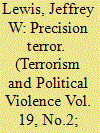

|
|
|
|
|
| Publication |
2007.
|
| Summary/Abstract |
Suicide bombing can be understood as a technology that successfully integrates people, cultures, and hardware into precise, intelligent, lethal weapons systems. Lacking access to the sophisticated electronic guidance systems of their enemies, terrorists have developed a cost-effective alternative technology by using social and cultural pressure to convert human beings into guidance systems for terrorist ordnance. This demonstrates that while terrorists tend to be imitative in their technologies, they can still be effective and difficult to predict. A significant implication that arises from this discussion is that the American tendency to assume that "high-tech" devices will automatically confer an advantage on the United States in the struggle against terrorism should be reconsidered.
|
|
|
|
|
|
|
|
|
|
|
|
|
|
|
|
| 7 |
ID:
097154


|
|
|
| 8 |
ID:
189000


|
|
|
|
|
| Summary/Abstract |
How does exposure to aerial bombing influence voting for the target country’s leadership? Do voters tend to punish incumbents for policy failure? These questions are relevant for understanding the target country’s postwar politics because aerial bombing remains one of the deadliest and most widely used military options for coercive bargaining. Despite the historical and contemporary relevance of these questions, there are only a few studies in the air-power literature arguing that strategic bombing produces a temporary rally effect but no subsequent political consequences other than political apathy. Most studies ignore important variation within states even though leadership responsibility can vary tremendously on the substate level. This article analyzes the effect of the 1999 NATO bombing of Yugoslavia on Serbian local elections using the difference-in-differences identification strategy and identifies the effect of airstrikes on the vote-share of Slobodan Milosevic’s regime. The results show that the regime’s vote-share is 2.6% lower in municipalities exposed to the bombing. Challenging prior studies, this finding demonstrates that retrospective voting applies to aerial bombing even in competitive authoritarian regimes.
|
|
|
|
|
|
|
|
|
|
|
|
|
|
|
|
| 9 |
ID:
077070
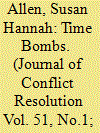

|
|
|
|
|
| Publication |
2007.
|
| Summary/Abstract |
Advancements in technology coupled with the perception of diminished public tolerance for casualties have increased the prominence and popularity of aerial bombing as a coercive tool, particularly for the United States. Despite interest from policy makers and support from the public, there has been little scholarly assessment of these coercive episodes. How successful are air campaigns, and what are the prospects for the future? In this article, I focus on the factors that cause bombing campaigns to end. To explore what leads to campaign termination, I highlight the theoretical significance of the political characteristics of both the attacker and the adversary. Using competing risks duration analysis to examine both failed and successful bombing campaigns from 1917 through 1999, I find that a democratic government on either side of the coercive equation increases the likelihood of campaigns ending
|
|
|
|
|
|
|
|
|
|
|
|
|
|
|
|